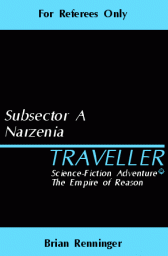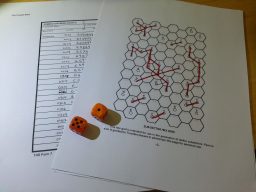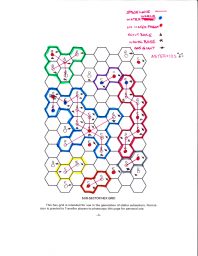Classic Traveller: Gearing Up for a Campaign
Thursday , 18, May 2017 Tabletop Games, Traveller, Uncategorized 11 Comments
Generated via Zhodani Base
Space Opera seems to be in the air these days. And, I gues I’m not immune. I’ve been talked into it. It being running a Classic Traveller game. Which is the original and first Space Opera role playing game. The wrinkle we are taking is to play Proto-Traveller (term coined by this blog’s el jeffe Jeffro Johnson) by which I mean playing using solely the original Books 1-3 first published in 1977. Partly this is a conceptual exercise but, partly it’s to keep things simple. There are a lot of books just included in Classic Traveller. And, I want to keep the things to keep track of small. Plus, my main goal to is try really playing the trading rules which have been present from the start.
A key thing to note is that like Michael J. Fox has no Elvis in him, Books 1-3 have no Imperium in them. And, no subsectors. It’s up to the GM to make the setting. Given that, the first thing to do is to create a subsector. Book 3 presents a method for creating a subsector and worlds within it solely using tables and random dice rolls. Which I did; and, I didn’t fudge any of the rolls. Without going into the play by play of each roll, here’s the first draft of what I rolled. Note: I made zero decisions here, it was entirely stochastic. That’s the systems, starport type and Space Lanes. Notice I have done this manually. There are online subsector generators available but, none of them that I have found use the 1977 rules. And besides manual methods are just fine. This is handcrafted bespoke Traveller.

Now, that I have the systems and Space Lanes outlined what to notice? Well, the Spacelanes are fractured. So, my first decision is that each grouping of Space Lanes will be its own polity or, “empire”, if you will. Though, looking at some of these systems, empire is likely too highfalutin a word. Three major empires and four minor empires. Plus a scattering of non-aligned systems.
Then I rolled the details. I won’t present the details of each system. But, here are some summary statistics.
| Total # Systems | 41 |
| Hightest Tech | 12 |
| Lowest Tech | 0 |
| Planets 1,000,000+ pop | 12 |
| Planets <10,000 pop | 20 |
| Starports | # |
| A | 4 |
| B | 10 |
| C | 13 |
| D | 6 |
| E | 8 |
| Rich | 2 |
| Poor | 5 |
| Industrial | 0 |
| Non-Industrial | 36 |
| Agricultural | 5 |
| Non-Agricultural | 2 |
| Scout Bases | 9 |
| Naval Bases | 7 |
| No Gas Giant | 5 |
The average system looks like this (with Mars for comparison):
| Diameter | Atmos | Hydro | Population | Gov | Law | Tech | |
| Average | 4 | 5 | 4 | 4 | 5 | 5 | 8 |
| Mars | 4 | 3 | 0 |
And, with more details filled in:


The average planet is about the size Mars with a barely breathable atmosphere and quite a bit more water. And, is settled by tens of thousands of people with technology around that of 1980s earth with a few extras. Half the planets have 10,000 or less population. Frontier worlds.. These will be hardscrabble places. This is not a rich subsector. It is both non-industrial and not particularly agrarian. The average settlement should be close to disaster at any moment. Looks like a place ripe for a group of opportunistic characters to become big dogs in a small pond. And, the wonderful thing is I had to make very few decisions: just the names of things (most of which I took from random name generators); the borders of the polities; the location of capitals; and a rough idea of the relations between the polities.
Here is what told players:
Here’s a more detailed sector map plus some player info of places in the sector. Assuming starting in the Capital of The Empire of Reason which is Ladfaus (hex 0605). You can put air quotes around the “reason”. I assume characters were raised somewhere in the Empire of Reason and have worked their professional lives in the Empire. So, I give the details of all the Empire’s systems. Plus other interstellar polities are shown along with stats for an average system in that polity. No one has traveled outside the Empire.
Other things to know. The interstellar polities are superficial layers on top of each systems gov type. The Empire of Reason has to an extent Finlandized the Kingdom of Calapia. New Assam is a colony of the Kingdom of Calapia. The Irural Sultanate has been the off and on enemy of Empire of Reason (currently at peace). The whole subsector is beset by pirates and Libertalia is blamed. Hold Fast is pretty isolated from the rest of the sector due to its proximity to Libertalia; no one knows how they manage to survive. Dirksland is ruled by one man and his extended family; can you guess his name? There isn’t a lot of trade outside each polity (hence no connecting Space Lanes) but, the bold do try it; some come back.
A few Notes: maximum tech level in the Empire is C (12). So, you can outfit characters with level C (12) or lower tech at the standard prices. Same with computers/software for ships, drives, etc.
If you character has rolled a Free Trader, my NPC Poul der Löwe is willing to invest his Free Trader roll to knock a decade off the payments in exchange for a minority share in the ship. Each ship is a 40 year loan. Each free trader roll knocks a decade off payments if rolled into another ship.
They already have greedy eyes on Dirksland and Hold Fast. More to come as development and play occurs.
Holy Smoke! Those maps really take me back; they’re exactly like the ones we used back in the day, color coding and all. But if you’re using just the first three books and the tech available at that time, as you are, most games will have the same look.
Keep us posted, this looks like it could be fun.
-
I’ll keep posting as I make new stuff and as the game progresses.
Classic Traveler! 🙂
The real beauty of systems like this is how a rich world of background, characters and events take shape during play…
-
Yes, the emergent properties are a nice feature. The individual rolls may not make sense (like tiny world thick atmosphere) but, it forces you to use your imagination to come up with a story for why they do.
And, I love not needing to know a ton of background ahead of time. Riffing off of what happens in play spontaneously generates an organic feel. RPGs are jazz not symphonies.
-
Titan is a pretty tiny world with a thick atmosphere. It happens.
-
True, but, Titan is size 3 in Traveller terms. In the classic Traveller approach you can get size 1 words with breathable atmospheres. Zhodani Base talks about it a bit here.
http://zho.berka.com/2012/05/16/my-house-rule-for-planetary-size/
His solution is to raise the minimum size of a world. While I agree with him about the issue, I disagree with his solution. ZB feels assuming over the top frequency of exotic metal planets or lost alien super science terraforming gets silly due to the frequency of occurrence. So, he changes the sizes. I say embrace it. Space Opera is supposed to be over the top and full of ineffable mystery. But, it does depend on what sort of setting you are going for. I am using the tables as-is.
-
-
Great rundown! I love how the game includes these ‘mini game’ elements, like system generation, or trade.
Hmm, the wiki page for Proto-Traveller has not kept up with the thread on Proto-Traveller over on Citizens of the Imperium (who also host the wiki…).
You might want to link to Jeffro’s original definition for Proto-Traveller…
I believe Alex Shcroeder improved his subsector generation to include a CT option, based on Chris Kubasik’s discussion of the 1977 v 1981 CT rules. You may want to check out https://campaignwiki.org/traveller/edit?classic=1 and naviigate around his rpg stuff. Some of it is very nice indeed.